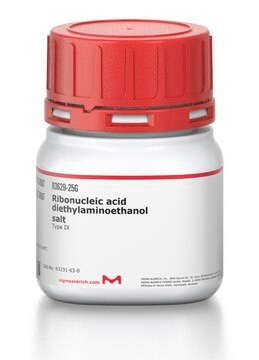S0885
Somatostatin
γ-irradiated, powder, BioXtra, suitable for cell culture
Synonym(s):
Growth hormone release inhibiting factor, SRIF, Somatostatin-14, Somatotropin release inhibiting factor
Sign Into View Organizational & Contract Pricing
Select a Size
All Photos(1)
Select a Size
Change View
About This Item
Empirical Formula (Hill Notation):
C76H104N18O19S2
CAS Number:
Molecular Weight:
1637.88
Beilstein/REAXYS Number:
6436064
EC Number:
MDL number:
UNSPSC Code:
12352209
PubChem Substance ID:
NACRES:
NA.77
biological source:
synthetic (organic)
form:
powder
assay:
≥50%
Recommended Products
biological source
synthetic (organic)
Quality Level
sterility
γ-irradiated
product line
BioXtra
assay
≥50%
form
powder
potency
0.3-50 ng/mL
concentration
≥50% (HPLC)
technique(s)
cell culture | mammalian: suitable
solubility
cell culture medium: 10 mL/vial
Looking for similar products? Visit Product Comparison Guide
Amino Acid Sequence
Ala-Gly-Cys-Lys-Asn-Phe-Phe-Trp-Lys-Thr-Phe-Thr-Ser-Cys
Biochem/physiol Actions
Somatostatin regulates endocrine function and cell proliferation via interaction with G-protein-coupled somatostatin receptors. It exists in two active forms produced by alternative cleavage of a single preproprotein (14 aa and 28 aa forms). Somatosatin inhibits the release of growth hormone; thyroid-stimulating hormone and a range of gastrointestinal hormones: Cholecystokinin (CCK); Enteroglucagon; Gastrin; Gastric inhibitory polypeptide (GIP); Motilin; Secretin; Vasoactive intestinal peptide (VIP).
Physical form
powder-0 °C; stock-frozen in working aliquots, avoid repeated freeze/thaw
Reconstitution
To prepare 2 μg/ml stock solution, add 10 ml sterile culture medium.
Storage Class
11 - Combustible Solids
wgk_germany
WGK 3
flash_point_f
Not applicable
flash_point_c
Not applicable
ppe
Eyeshields, Gloves, type N95 (US)
Choose from one of the most recent versions:
Already Own This Product?
Find documentation for the products that you have recently purchased in the Document Library.
Customers Also Viewed
Henrik H Hansen et al.
The Journal of pharmacology and experimental therapeutics, 350(3), 657-664 (2014-07-06)
Type 2 diabetes is characterized by impaired β-cell function associated with progressive reduction of insulin secretion and β-cell mass. Evidently, there is an unmet need for treatments with greater sustainability in β-cell protection and antidiabetic efficacy. Through an insulin and
Amelie Soumier et al.
Neuropsychopharmacology : official publication of the American College of Neuropsychopharmacology, 39(9), 2252-2262 (2014-04-03)
Reduced expression of somatostatin (SST) is reported across chronic brain conditions including major depression and normal aging. SST is a signaling neuropeptide and marker of gamma-amino butyric acid (GABA) neurons, which specifically inhibit pyramidal neuron dendrites. Studies in auditory cortex
Optogenetic excitation of preBötzinger complex neurons potently drives inspiratory activity in vivo.
Zaki Alsahafi et al.
The Journal of physiology, 593(16), 3673-3692 (2015-05-27)
This study investigates the effects on ventilation of an excitatory stimulus delivered in a spatially and temporally precise manner to the inspiratory oscillator, the preBötzinger complex (preBötC). We used an adeno-associated virus expressing channelrhodopsin driven by the synapsin promoter to
Yuko Takano et al.
PloS one, 10(7), e0133812-e0133812 (2015-07-21)
Animal models with defective glucagon action show hyperplasia of islet α-cells, however, the regulatory mechanisms underlying the proliferation of islet endocrine cells remain largely to be elucidated. The Gcggfp/gfp mice, which are homozygous for glucagon/green fluorescent protein knock-in allele (GCGKO)
M Hadi Saiepour et al.
Current biology : CB, 25(6), 713-721 (2015-03-11)
To ensure that neuronal networks function in a stable fashion, neurons receive balanced inhibitory and excitatory inputs. In various brain regions, this balance has been found to change temporarily during plasticity. Whether changes in inhibition have an instructive or permissive
Our team of scientists has experience in all areas of research including Life Science, Material Science, Chemical Synthesis, Chromatography, Analytical and many others.
Contact Technical Service








